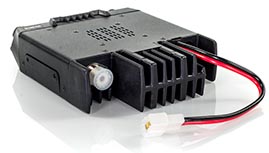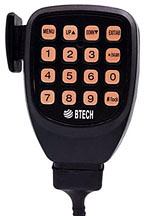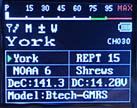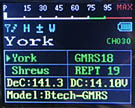Ham Radio - Camera -
Computer - F8HP - UV5R - Baofeng - Pofung
Product Review
BTECH GMRS-50V2
50W GMRS Mobile
Part 95E / 15B
by: John 'Miklor'
February 16, 2023
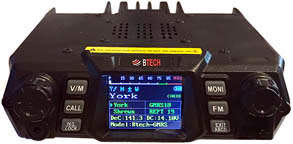


Product Review
BTECH GMRS-50V2
50W GMRS Mobile
Part 95E / 15B
by: John 'Miklor'
February 16, 2023


|
General Description
The new BTech GMRS-50V2 50w mobile is an upgraded version of its predecessor (the GMRS 50X1). The radio is Part 95E and 15B certified for GMRS use in the US and comes pre-programmed with the GMRS repeater and simplex channels along with the capability of storing and scanning over 200 VHF and UHF receive only channels. Upgrades added to the new Version 2 -- The PCB design itself has been upgraded. -- Better receive (less noise) -- Better power stability. Retains its maximum power on long transmissions. -- The RJ-45 jack now allows for the use of handheld accessories and VOX for hands free use. -- Firmware updates include fully customizable channel list with quick add menus for GMRS channels without the need to know the frequencies. -- The 50V2 can be programmed to transmit on all 256 channels as long as they are assigned to GMRS channels. No longer restricted to 20 channels. In the Box Included with the radio are: - Microphone with a 16 button keypad - Chrome metal microphone hanger - Metal mounting bracket with screws - Heavy Duty DC Power Cable (HD Auto Fuses) - Full 78 page English User Manual The 50V2 Weighs in at a hefty 2.24 lb (1.0 kg) Chassis Size is 5.7" (W) x 1.9" (H) x 7.5 (D)" (145 x 47 x 190 mm) FCC Part 95E certified - 2AGND50V2G Frequency Range 136-174 MHz 400-520 MHz (Rx) 15 GMRS - 2way Simplex (Tx/Rx) 8 GMRS - 2way Repeater (Tx/Rx) GMRS Channels (Rx/Tx) (Channels 001-007, 015-030) GMRS Channels (Rx Only) (Channels 008-014) 256 - Memory Channels Rx channels (Rx) 65-108 MHz FM Broadcast Radio (Rx) Specifications The GMRS-50V2 is a full 50W GMRS transceiver that supports options such as display synchronization, microphone gain control, the ability to alter channels on the fly without the need for software, and a few others. A full specifications can be found HERE (Page_66,67). Enclosure and Mount The main chassis weighs in at a solid 2.2lb with a top finned heat sink and cooling fan in the rear. The radio is terminated with a standard SO-239 connector with heavy duty dual fusing.
Transmitter I used my 13.8VDC power supply to emulate a standard auto battery. The high power rating is projected to be 50W on high power. Running the radio into a calibrated Bird Wattmeter for 2 minutes showed a solid 48W.
The 50V2 can be programmed to transmit on all 256 channels as long as they are assigned to GMRS channels. The prior model was restricted to 20 transmit channels. All other channels were receive only. Microphone & DTMF Gain Controlling Audio reports are excellent. One of the nice features is the microphone gain control. It allows me to advance the gain for operation at home so I can back off the microphone a bit, and reduce the gain when mobile to avoid picking up road and background noise. Be careful when setting the level. Only move the level up a few points at a time. Although the range is 0-127, reports show that level 10-15 is ideal. Anything higher than that is way too hot. Along with the microphone gain, there is also an option to vary the DTMF gain for control operation.
The GMRS 50V2 has both a Wide and Narrow receiver, depending on the mode selected with a 2W audio section that provides plenty of volume. This mobile has the ability to display four frequencies on its new display. The TMR option (Transceiver Multi-Receive) allows any 2, 3, or 4 displayed channels to be selected for 'on screen' scanning. If a selected channel becomes active, the display will lock onto that channel and remain there for a predetermined amount of time before resuming the scan. This is a great option when traveling to a new area and not knowing which repeaters are the most active. The scan rate is 3 to 4 channels per second. Fast enough to go through the four channels and not miss a call. Channel Scanning Normal channel scanning is still available with a little added bonus. I can now add or delete a channel from the scan group on the fly. This eliminates my need to reprogram using software to make minor change. Another option I found was the ability to set the scan mode to start or resume immediately upon power up. This saves a few steps if you like to keep your radio in the scan mode. Display / Display Syncing The face design includes a much improved OLED* display (1 3/8 x 1 1/8") with nine color choices that can be configured in any combination of your choice. While the background remains Black, the available foreground colors are White, Red, Blue, Green, Yellow, Indigo, Purple, and Gray, giving virtually thousands of color combination possibilities. I found the resolution of the new OLED display excellent. Regardless of the color, the display is bright and extremely clear. No more squinting. My iPhone didn't capture the display image as well as I had hoped, but this will give a rough idea of the various color capabilities. * Organic Light-emitting Diode
The 50V2 includes display synchronization. I can select display pairs. (A/B, C/D, or A/B C/D) and pair them together. When changing channel, the selected pair tracks together, displaying both the repeater name and frequency. That gives me the best of both readouts. The screen clarity is amazing.
Programming One new capability I found extremely helpful was the ability to change channel parameters such as CTCSS tones, power, and 'scan add' via the keypad, without the need for deleting and reentering the channel data. The programming software for this radio is CHIRP-next (Latest Daily Build) Mobile Power Cable All power cables are not created equal. If your radio has a maximum output of 25W, it will require approximately 5-6A from your battery or power supply. This is well within the range of the average cars accessory socket which is normally fused at 10A. If you are using a radio that runs 50W, such as the GMRS-50V2, it is going to draw between 10-13A, requiring a connection directly to the battery or fuse block. Base Station Operation When choosing a power supply for base station operation, a 50W (11-12A) requires a power source capable of 15-20A continuous (not just surge) for proper operation. A 25W (5-6A) will require a power source of at least 8-10A continuous. An insufficient power supply put strain on both the supply and radio resulting in damage or equipment failure. Here are a few power supply Examples that may assist. In Summary It looks like BTech took a great design and brought it to the GMRS world. It is based on a proven design, and I have found no issues with the radio while testing. The main features include: - Memory / Tone modifications on the fly - LCD Display synchronization - LCD programmable color options - Adjustable microphone gain - Adjustable DTMF gain - Scan resume options - Quad Watch display - Scanning start / return on Power On BTech took a great performing mobile and took it to the next level. Note: This equipment was received for the purpose of a fair and unbiased review. All findings are factual based on the equipment I received. No issues were found during to review of this mobile.
|
|||||||||
 UV-50X2 50W Dual Band -Review-  UV-25X4 25W Tri Band -Review-  UV-25X2 25W Dual Band -Review- ^ PC04 ^ Programming Cable (for above)  UV-50X3 Tri-Band -Review- ^ PC05 ^ Programming Cable (for above) |
